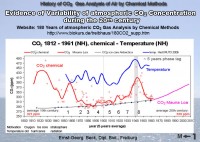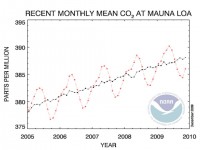By Ernst-Georg Beck
A new study on preindustrial CO2 from stomata proxis confirms my findings on pre-Keeling CO2: variation! A role for atmospheric CO2 in preindustrial climate forcing by Thomas B. van Hoof, Friederike Wagner-Cremer, Wolfram M. Kurschner, and Henk Visscher, PNAS September 30, 2008.
Abstract
Complementary to measurements in Antarctic ice cores, stomatal frequency analysis of leaves of land plants preserved in peat and lake deposits can provide a proxy record of preindustrial atmospheric CO2 concentration. CO2 trends based on leaf remains of /Quercus robur/(English oak) from the Netherlands support the presence of significant CO2 variability during the first half of the last millennium. The amplitude of the reconstructed multidecadal fluctuations, up to 34 parts per million by volume, considerably exceeds maximum shifts measured in Antarctic ice. Inferred changes in CO2 radiative forcing are of a magnitude similar to variations ascribed to other mechanisms, particularly solar irradiance and volcanic activity, and may therefore call into question the concept of the Intergovernmental Panel on Climate Change, which assumes an insignificant role of CO2 as a preindustrial climate-forcing factor. The stomata-based CO2 trends correlate with coeval sea-surface temperature trends in the North Atlantic Ocean, suggesting the possibility of an oceanic source/sink mechanism for the recorded CO2 changes.

See larger image here
See more here. New findings indicate a natural climate cycle occurring approximately every 65 years (50-80 y). Modern state of the oceans is similar to the oceans during the 30s in the 20th century. During the strong arctic warming since 1918 the oceanic currents had brought warmer water to the CO2 absorption areas near Greenland-Iceland-Spitsbergen than at the end of the 19th century. High salinity, pH and other characteristics inclusive a spread of phytoplankton had been measured during this warm period in the northern Atlantic ocean as we see today with its special 13C signature. These ocean currents were responsible for warmer climates in the northern continents at that times and colder climates in their cold phases (around 1900 and 1965).
The strong heating of the CO2 absorption areas, which occurs in a multi-decadal cycle (approx. 1780, 1850, 1935, 2000, evidence for the last two cycles) prevents a stronger CO2 absorption by the arctic oceans and thereby enriches the atmosphere with more CO2 than in the colder phase of the cycle. These cold and warm phases of the ocean current cycle correlates with a cycling of the geomagnetic index (SSC) and solar activities (Gleissberg cycle), a function of the chaotic, non-linear solar dynamo.

See larger image here
See also this detailed report by Dr. Zbigniew Jaworowski.




